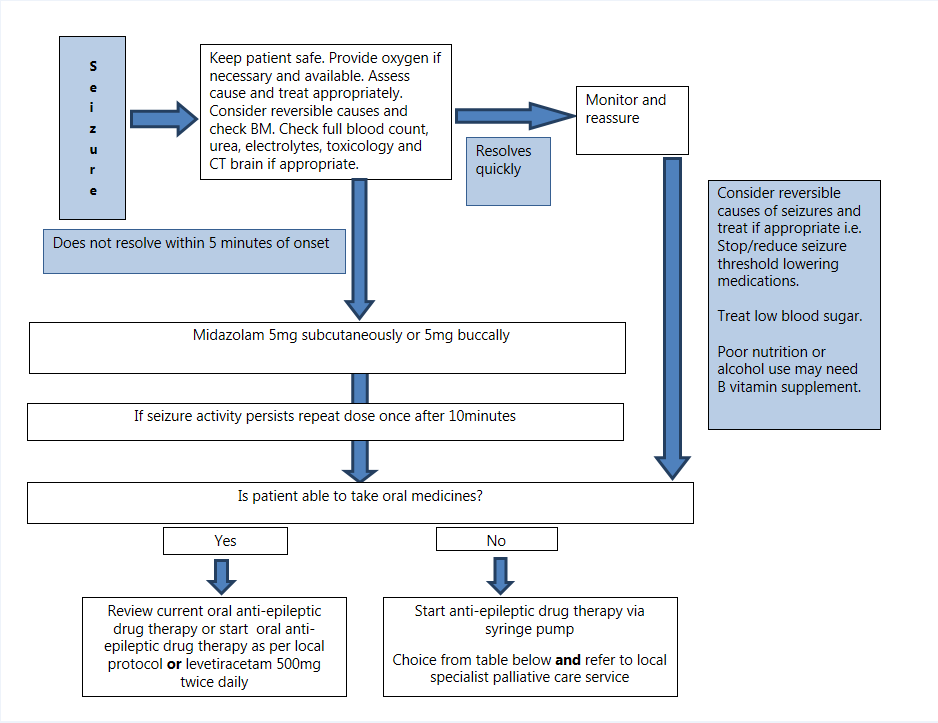Scottish Palliative Care Guidelines - Levetiracetam (Subcutaneous Infusion). 2018 [cited 2019 February 08]; Available from https://www.palliativecareguidelines.scot.nhs.uk/guidelines/medicine-information-sheets/levetiracetam-(subcutaneous-infusion).aspx
British National Formulary.2017. Available from https://www.medicinescomplete.com/mc/bnf/current/PHP-bnf-interactions-list.htm
BMJ Best Practice. Focal seizures. 2018 [cited 2018 Oct 04]; Available from: https://bestpractice.bmj.com/topics/en-gb/544.
BMJ Best Practice. Generalised seizures. 2018 [cited 2018 Oct 04]; Available from:https://bestpractice.bmj.com/topics/en-gb/543.
Dickman A, Schneider J. The Syringe Driver. 4th ed: Oxford University Press; 2016.
Freiherr von Hornstein W, editor. Levetiracetam continuous subcutaneous infusion in the management of seizures. First experience. Poster presentation IAPC Education & Research Seminar 2014.
Freiherr von Hornstein W, O'Gorman A, Richardson J, Wilson M, Carroll M, editors. Successful Management of Seizures until the End of Life using Levetiracetam Continuous Subcutaneous Infusion. Poster presentation NCRI Cancer Conference Abstracts; 2014.
Kerrigan S, Grant R. Antiepileptic drugs for treating seizures in adults with brain tumours. 2011 [cited 2018 Oct 04]; Available from: https://www.cochranelibrary.com/cdsr/doi/10.1002/14651858.CD008586.pub2/epdf/standard.
Lopez-Saca JM, Vaquero J, Larumbe A, Urdiroz J, Centeno C. Repeated use of subcutaneous levetiracetam in a palliative care patient. J Pain Symptom Manage. 2013;45(5):e7-8.
NICE. Epilepsies: diagnosis and management CG137. 2018 [cited 2018 Oct 04]; Available from: https://www.nice.org.uk/guidance/cg137.
Pruitt AA. Medical management of patients with brain tumors. Continuum (Minneap Minn). 2015;21(2 Neuro-oncology):314-31.
Remi C, Lorenzl S, Vyhnalek B, Rastorfer K, Feddersen B. Continuous subcutaneous use of levetiracetam: a retrospective review of tolerability and clinical effects. J Pain Palliat Care Pharmacother. 2014;28(4):371-7.
Royal Pharmaceutical Society. BNF - Levetiracetam. 2018 [cited 2018 Oct 04]; Available from: https://www.medicinescomplete.com/#/content/bnf/_695768521.
SIGN. Diagnosis and management of epilepsy in adults No143. 2015 [cited 2018 Oct 04]; Available from: https://www.sign.ac.uk/our-guidelines/diagnosis-and-management-of-epilepsy-in-adults/.
Twycross R, Wilcock A, Howard P. Palliative Care Formulary PCF6. 6th ed. England: Pharmaceutical Press; 2017.

